The age-old question, “Can spiders swim?” With more people around the world keeping spiders as pets, many of us have wondered if our eight-legged buddies can take a dip and hit the aquatic scene.
The short answer is yes, some spiders do swim! In fact, there is one species in particular, that not only swims but, also hunts on the water, called the Dolomedes “fishing spider”.
Types Of Spiders That Can Swim
| Spider Species | Habitat | Description |
|---|---|---|
| 1. Fishing Spider | Aquatic environments such as streams and ponds | Fishing spiders are known for their ability to walk on water and swim. They can detect vibrations on the surface of the water to locate prey, and then dive into the water to catch their food. |
| 2. Diving Spider | Ponds, lakes, and streams | Diving spiders are named for their ability to swim underwater. They use air bubbles held in a layer of trapped hair around their body to breathe while underwater. |
| 3. Great Raft Spider | Ponds and slow-moving water | Great raft spiders are known for their ability to create a raft out of spider silk and float on the surface of the water. They can also swim underwater using their legs. |
| 4. Wolf Spider | Occasionally found by steams and also wooded areas | While not aquatic, some species of wolf spiders have been observed swimming across small streams or crossing water surfaces when necessary. |
| 5. Nursery Web Spider | Found in tall grass, along wooded edges, in shrubs, and occasionally in houses. | Nursery web spiders are commonly in shrubs, and can also swim. However, it’s very rare for them to do so due to their inhabit. |
1. The Fishing Spider
The fishing spider “Dolomedes” is a special type of spider and an accomplished swimmer. They typically live near slow-moving streams or ponds and possess strong front legs which they use to scoop up their prey “fish” from the water.
Their impressive hydrophobic hairs allow them to float on top of the water, or in some cases, dive under the surface, to pursue their prey or escape danger.
But, what’s even more amazing is that these spiders can stay submerged for up to 25- 30 minutes thanks to their hydrophobic hairs, and Book lungs.
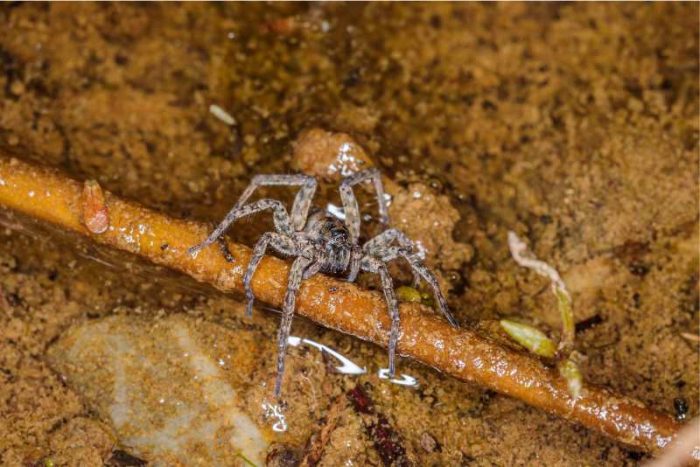
Book lungs are actually a type of respiration organ that is present in many arachnids. These special lungs are located within small openings in the spider’s abdomen and are used for atmospheric gas exchange which “in short” helps the spider breathe underwater.
This spider is also very similar in appearance, and size, to another species called “the wolf spider”. So much so, that it’s often mistaken for this species. Fishing Spider Vs Wolf Spider: What’s The Difference?
2. The Wolf Spider
Which brings us to the mighty wolf spider! Although the wolf spider “Lycosidae“ is very similar in size, and appearance, they are much more darker than the fishing spider. They also have the same hydrophobic hairs on their body giving them the ability to swim.
However, while wolf spiders are not primarily aquatic, some species have been observed swimming when necessary, such as when crossing small streams or traversing water surfaces.
When a wolf spider swims they use a technique described as “row and drag.” Similar to insects like the “water boatman”.
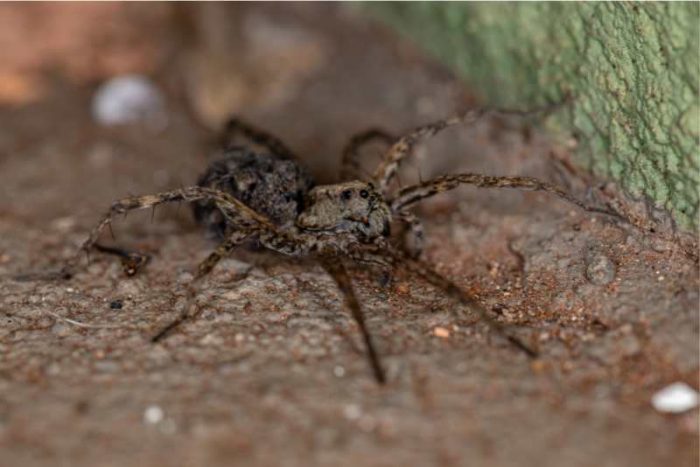
This technique involves moving their legs in a rowing motion like oars and using their bodies to create a wake that propels them forward through the water. The wolf spider’s large size and powerful legs make this swimming technique effective for short distances.
It’s worth noting that while wolf spiders are capable of swimming, it’s not a frequent occurrence as they tend to hunt and stalk their prey on land. Swimming is typically only used as a last resort when the spider is forced to cross the water.
3. The Diving Spider
Although it’s the fishing spider that gets all the attention! There is one spider, that not only swims in water but actually spends its entire life underwater called the diving spider “Argyroneta aquatica” In fact, this is the only known species of spider that does this.
They are typically found in shallow water, such as ponds, lakes, and slow-moving streams, where they dive to the bottom and construct a nest or burrow made of silk.
They coat their silk nests in a layer of air bubbles that they carry down with them during dives, creating a kind of underwater “diving bell”
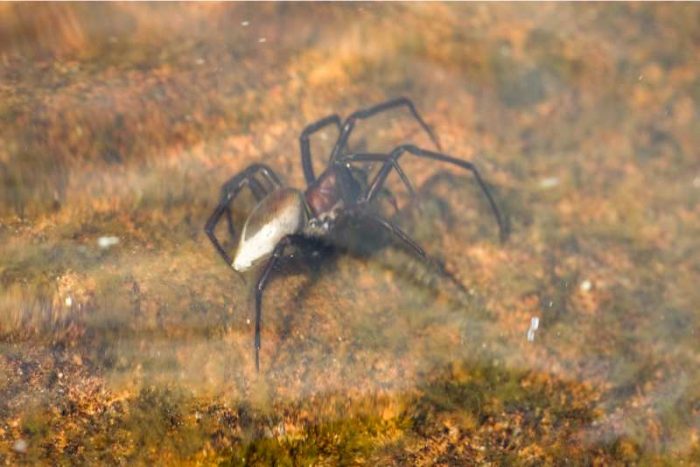
They also have dense layers of hydrophobic hairs on their abdomen and legs “like the spiders mentioned above” This helps them breathe by providing a pocket of air “air bubbles” in which they extract the oxygen.
The diving spider briefly surfaces, only to replenish its oxygen, or to bring their prey to the surface. Their remarkable ability to live completely underwater is a fascinating adaptation that really does set them apart from other spiders.
4. The Great Raft Spider
Next on our list, is the great raft spider, ”Dolomedes fimbriatus” also known as the European raft spider. This species is a semi-aquatic spider that lives close to freshwater, specifically wet heaths, bogs, or acid swamps.
They are named after their unique ability to create rafts out of silk and float on the surface of the water. They can also swim underwater using their legs to paddle.
These raft spiders have been found swimming across the water with their front appendages outstretched. However, they only swim in order to find prey like beetles, or pond striders.
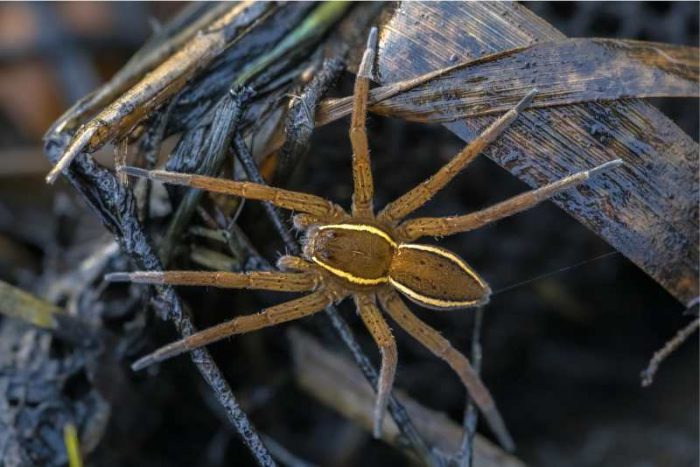
Although the raft spider is mainly semi-aquatic, they are also a competent climber and can scale grass and reeds “if needed” to find prey. With that said, raft spiders will typically construct their webs close to the water.
5. The Nursery Web Spider
The nursery web spider, like the wolf spider, has a similar appearance with brown or grayish coloring and long legs. However, there are some distinct differences such as the pattern on the spider’s abdomen.
Despite their similarities in appearance, the two species are different in terms of their habitat, behavior, and lifestyle.
Although the nursery web spider is capable of swimming, it is quite rare for them to do so. They prefer to live in areas such as tall grass, along wooded edges, in shrubs, and occasionally in houses.
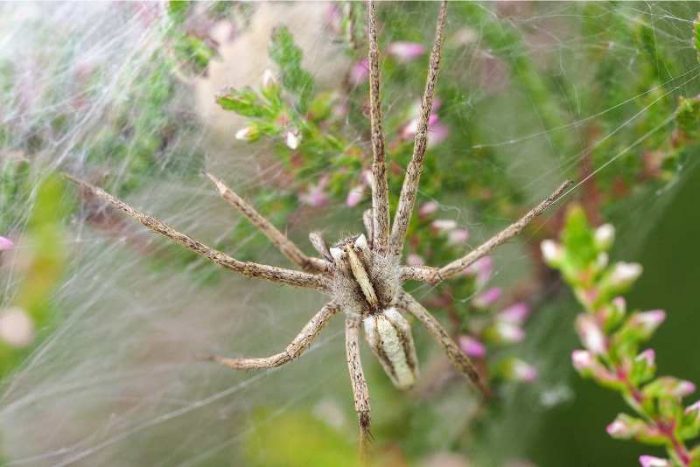
This makes swimming an uncommon activity for these spiders, as they live in primarily terrestrial environments.
While swimming may not be an everyday occurrence for the nursery web spider, their ability to adapt and survive in diverse environments is still impressive. Earning its place among this list.
Can Tarantulas Swim?
Some species of tarantulas have been known to swim for short distances. They do this by using their legs to paddle and move through the water. However, this is not a natural behavior for them, and they are not accustomed to it.
In general, tarantulas prefer to live in dry environments and avoid water sources. Which is why they are not added to the list above.
Spiders Swimming Technique
Although we have already talked about these two topics, we wanted to go into more detail so you have a better understanding of how spiders can swim exactly.
Hydrophobic Hairs
Hydrophobic hairs refer to a type of hair covering the legs of many spider species, which are water-repellent, or hydrophobic in nature. Due to this specialized arrangement, spiders are able to float on the surface of the water, using the surface tension of the water to their advantage.
For example, all the spiders, mentioned above, use their hydrophobic hairs to create air pockets, which allow them to float on the water surface without sinking, as if they were walking on water.
Book Lungs
Book lungs are respiratory organs that spiders use to breathe air. However, they are not like the average lungs that we humans have. Instead, they are composed of several inner plates and outer flaps housed in an internal respiratory chamber.
These inner plates have many thin layers and are folded in a way that maximizes surface area for gas exchange. As a result, the spider is able to breathe underwater.
Diving spiders, for example, use this technique to survive for long periods of time underwater.
Can Spiders Drown If They Swim For Too Long?
Yes! Even spiders with adaptations that allow them to stay underwater for extended periods, will eventually need to come up for air.
Like all living beings, spiders require oxygen to survive, and extended periods underwater can put their lives at risk, even for the diving spider!
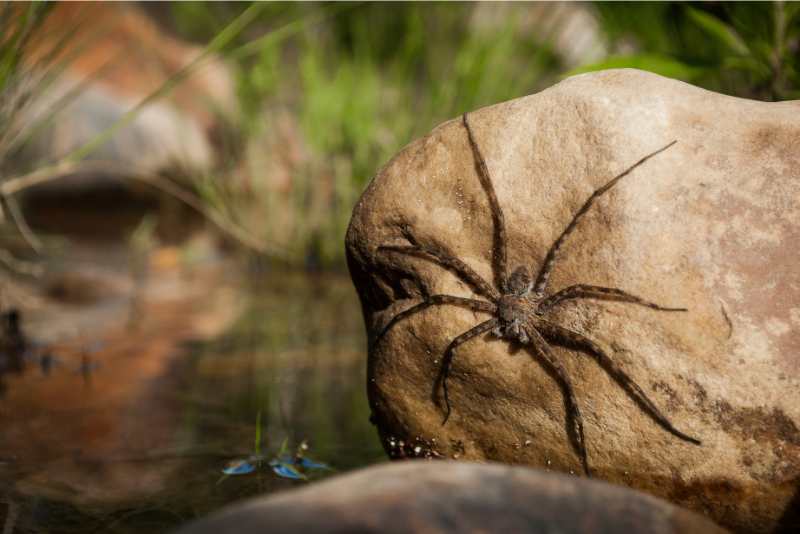
Related Questions
Can House Spiders Survive In Water
House spiders are not adapted to living or surviving in water for extended periods. Although they may be able to survive for a short time until they are exhausted, they don’t possess the swimming techniques.
Can Spiders Swim Up A Toilet Seat?
While it is possible for spiders to crawl up toilet seats and swim through the water in a toilet bowl, it’s important to note that this depends largely on the species of spider.
Some spiders are better adapted to live near water sources and may be more likely to venture into a toilet bowl, while others prefer dry areas.
How Long Can Spiders Survive In Water?
The length of time a spider can survive in water varies depending on the species of spider, age, and the temperature of the water.
Spiders that live near or in water and have adapted to this environment, can survive underwater for several minutes to a few hours, depending on the conditions.
Conclusion
So there you have it! Now you know which spider species can swim, not only that, but you also know how they can do this.



